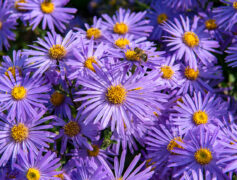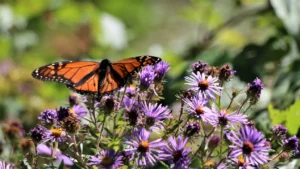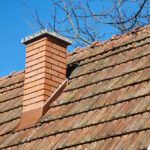
Goldenrods & asters: Important fall flowers for pollinators
Thanks to the University of Maryland/Maryland Grows this informative article about adapting to fall flowers for pollinators.
With the fall very clearly upon us, we tend to think more about falling leaves than flowers. Indeed, the big flower boom is ending, with all early-season flowers well past flowering. However, fall is a very important season for many pollinators. They still require food and shelter in preparation for the winter. In this blog, I would like to take a little bit of time to go over the importance of fall resources for pollinators. You’ll learn what you can do to make sure they are available in your green spaces.
Why is fall special in nature?
The end of summer/fall is a special time for many organisms in our temperate regions. This is usually the last chance these organisms have to gather energy and resources to get ready for the winter. In the case of pollinators that are active during this period, the fall is key for collecting sufficient pollen (=food) for their nests. Also important is finding appropriate overwintering spaces for the adults and/or the offspring (take a look at this post to learn more about this), all of which will impact survival until the following year/season. If we want to help these pollinators, making sure that these resources are available is the best we can do!
Providing food for pollinators in the fall
Several native plants in our area flower in the fall and act as wonderful resources of pollen and nectar (and more!) for our late-summer/fall pollinators. These plants are easy to grow and once established provide abundant (nutritional) resources for our local insects.
Goldenrods
This group (Solidago spp.) consists of many species which flower in the late summer/fall. These plants are perennials that will create patches once established in an area. For this reason, they are easy to grow, although for this very same reason may usually require a bit of containment, since otherwise, they will easily spread everywhere. If the latter is a problem, plants can be grown in pots, where the containment issue is more easily resolved.
These plants support a large community of many different types of bees (many of which are specialists that can use only specific types of pollen and can be rare), as well as butterflies, flies, and wasps. In fact, more than any other herbaceous plant studied by Fowler/Droege, goldenrod (species in the genus Solidago) supported the most specialist bees (39 species). Importantly, because these plants create tall hollow stems, they can also act as nesting resources for stem-nesting bees. This way, these plants are great fall resources for many of our pollinators.

Easy to Grow
Two easy-to-grow species that one can find in several native nurseries are the tall goldenrod (Solidago altissima) and Canada goldenrod (Solidago canadensis). Both species have long stems that end with many yellow inflorescences. Both of them flower in the late summer and fall and can be easily grown in green spaces, especially drier sites that are exposed to the sun. As said before, although these plants are great pollinator magnets and resources, they tend to spread readily, so, unless that is wanted, they require some control once they start spreading in an area.
Asters are another group of plants native to our region that acts as a great pollinator resource in the fall. These plants are also perennials and can be small or become shrub-like, depending on the species. Unlike the goldenrods we were talking about just above, these plants tend to display a larger variety of floral coloration. The flowers go from white, to pink, and purple, depending on the species. Like goldenrods, these plants provide both food and nesting sites to many pollinators.
Their flowers attract a very large variety of pollinators (bees, butterflies, flies, beetles, wasps) during a time when there is little else to feed on. The flowers of these plants are also known to support specialist and often rare bees, which depend strongly on its pollen for survival, as well as many butterflies, including Monarchs. Their stems are also great sites for stem-nesting bees. Finally, their leaves support the larvae of many local butterflies.

A lovely species that can be grown in our green spaces and provides hundreds of blue/purple flowers is the New England aster (Symphyotrichum novae-angliae). This perennial herbaceous plant can be obtained from nurseries. These asters will grow three to six feet tall in the summer (but it can be cut back in mid-summer if you want to keep it shorter). The plant requires at least some sun and does well in a variety of soils we find in Maryland. I love watching the lovely cute flowers, and all the activity they attract. This is really one of my personal fall garden highlights!
By Anahí Espíndola, Assistant Professor, Department of Entomology, University of Maryland, College Park. See more posts by Anahí.
Anahí also writes an Extension Blog in Spanish! Check it out here, extensionesp.umd.edu, and please share and spread the word to your Spanish-speaking friends and colleagues in Maryland. ¡Bienvenidos a Extensión en Español!
If you are looking to buy or sell your home (with or without a garden), contact Gigi today. Oh by the way, I’m never too busy for any of your referrals!






Recent Comments